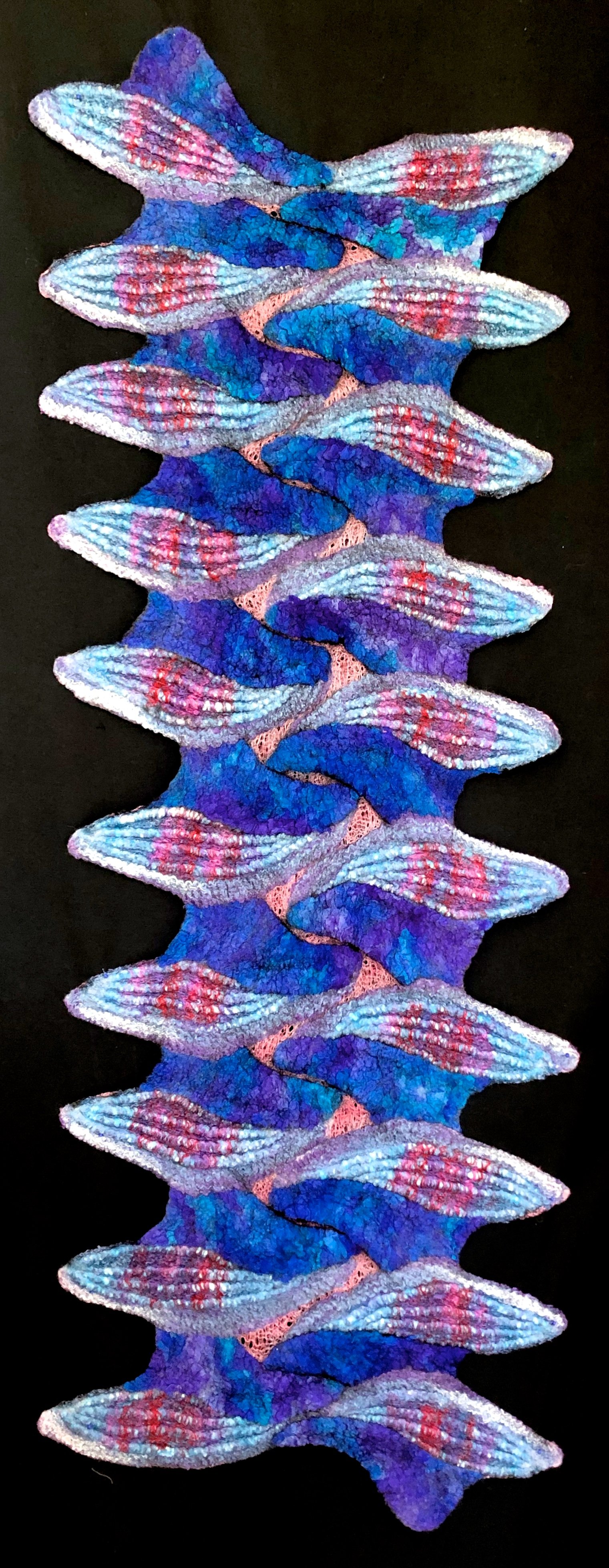William D. Cannon Art Gallery in Carlsbad, CA, presents California Fibers’ newest exhibit, Contemporary Perspectives in Fiber Arts, opening January 7 and continuing through March 18, 2023. Contemporary Perspectives in Fiber Arts features the work of twenty-five members of California Fibers – Sandy Abrams, Olivia Batchelder, Charlotte Bird, Ashley V. Blalock, Carrie Burckle, Marilyn McKenzie Chaffee, Ben Cuevas, Doshi, Gail Fraser, Polly Jacobs Giacchina, Susan Henry, Lydia Tjioe Hall, Brecia Kralovic-Logan, Anna Faye Korngute, Chari Myers, Serge Nepomnine, Kathy Nida, Carol Nilsen, Michael F. Rohde, Rebecca Smith, Cameron Taylor-Brown, Elise Vazelakis, Debby Weiss, Peggy Wiedemann and Aneesa Shami Zizzo.
Works selected for the exhibit express a wide variety of themes interpreted in diverse textile materials and processes – a hallmark of contemporary fiber art.
Carol Nilsen, Montecito
Hand-dyed and commercial silks, commercial metallics, vintage kimono and sari fabrics, metallic leaf. Translucent silks overlaid in layers over sari and kimono medallions, metallics, and metallic leaf on felt; machine stitched free-form applique
Carol Nilsen says of her work Montecito, “Flood followed fire, with boulders and trees riding thundering rivers of raging mud to form an unholy convergence that destroyed more than 20 lives and hundreds of homes, one of them ours. Climate change rewriting the surface of our reality.”
Ben Cuevas states that his piece, Non-binary Code, plays “with the binary nature of the knit/purl stitchwork inherent to knitting; I translated the word ‘nonbinary’ into binary code and knit this label of my gender identity into a textile wall hanging. The choice of medium—acrylic (yarn) on canvas—brings the work in dialogue with the history of white paintings in minimalist abstraction. I see this work as a queering of many supposedly binary hierarchies, complicating and challenging distinctions of art & craft, digital & handmade, male & female.”
Ben Cuevas, Non-binary Code
Rebecca Smith finds her inspiration for After Lenore in “the groundbreaking work of Lenore Tawney whose gauzy, open-weave techniques helped transform fiber art during the Fiber Revolution of the 1950s-1970s. I have explored how Tawney's innovative open weave can contribute to the transparent tapestry format that is practiced by Scandinavian weavers.”
Rebecca Smith, After Lenore
The Good War by Aneesa Shami Zizzo is a part of her Reclamation series, which "blends abstract memory landscapes with Islamic folklore. Using reclaimed fabric, collage methods and applique techniques, creating this piece relies on a making-while-meditating mindset to evoke a sense of the collective unconscious through material exploration."
Aneesa Shami Zizzo, The Good War
Charlotte Bird explains that her work Legacy “is a love letter to my mother-in-law. The pages are made from her damask table napkins. The cookie recipes printed on the pages are from her hand-written recipe cards. The name of the person she got the recipe from is in the upper right corner. The covers were molded out of paper maché using the waffle baker she used throughout her married life.”
Charlotte Bird, Legacy
Several artists are inspired by the rhythms of the natural world. One example is Autumn Maple Leaves by Serge Nepomnine, which expresses the beauty of fall colors “in the format of the Japanese paper scroll and is an impression of maple leaves on a sunny afternoon in mid-autumn.”
Serge Nepomnine, Autumn Maple Leaves
Spring Tides, a felted piece by Chari Myers, “reflects the quality of the light of the New Moon and Full Moon on the Spring Tides.”
Chari Myers, Spring Tides
Sandy Abrams states about her work Sanctuary, that she started “with a wonderful found piece of wood I constructed by twining rattan and covering that with rice paper, a refuge for the clay crows. From my observance, crows bond in large families and settle each night as a group. I am truly fascinated by their antics and camaraderie.”
Sandy Abrams, Sanctuary
The William D. Cannon Art Gallery is located in Plaza Paseo Real at 1775 Dove Lane in Carlsbad, CA. Hours are Tuesday, Thursday, Friday, and Saturday from noon – 5 pm, and Wednesday from noon – 7 pm. Admission is free. Please check their website for details about the exhibit, including the opening reception planned for January 7.








